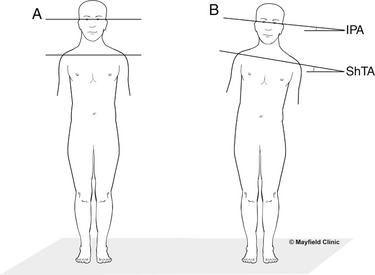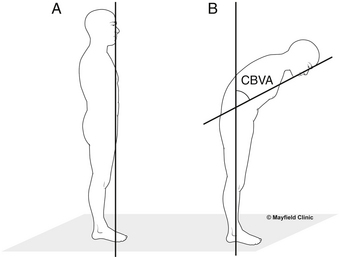Chapter 90 Spinal Deformity
Measuring, Defining, and Classifying
The spine is composed of regions with distinct alignment and biomechanical properties that contribute to global alignment. Although regional spinal curves vary widely from the occiput to the pelvis in asymptomatic individuals, global spinal alignment is maintained in a much narrower range for maintenance of horizontal gaze and balance of the spine over the pelvis and femoral heads. Spinal deformity is defined as a deviation from normal spinal alignment.1,2 Because the human condition is in part defined by the ability to comfortably stand upright and because the treatment of many patients with spinal disorders is directed at restoring this condition, spinal deformity needs to be defined in relation to neutral upright spinal alignment (NUSA) in asymptomatic individuals. NUSA in asymptomatic individuals is defined as standing with the knees and hips comfortably extended, the shoulders neutral or flexed, the neck neutral, and the gaze horizontal. Analysis of spinal alignment involves both clinical and radiographic evaluation. Although there are a myriad of angles and displacements for measuring spinal alignment, our subsequent analysis offers a systematic approach to analyzing regional and global spinal alignment.
Clinical and Radiographic Evaluation of Deformity
To evaluate a spinal deformity, it is necessary to do the following:
1. Perform clinical measurements (facilitated with photographs) in a neutral upright position (standing with the knees and hips comfortably extended, the shoulders and neck neutral) and a forward bend position (standing with feet together, the knees comfortably extended, the hips and spine flexed, and the arms dependent with fingers and palms opposed).
2. Measure occipitocervical and cervical angles and displacements on standard standing anteroposterior and lateral cervical spine radiographs in a neutral upright position (standing with the knees and hips comfortably extended, the shoulders and neck neutral).
3. Measure thoracic, lumbar, sacral, and pelvic angles and displacements, including spinal balance, on standard standing anteroposterior and lateral long cassette radiographs in a neutral upright standing position (standing with the knees and hips comfortably extended, the shoulders neutral or flexed [flexed for lateral radiographs], and the neck neutral).
4. Obtain side-bending (supine) and flexion-extension (standing) radiographs when appropriate for evaluating the flexibility of a deformity curve.
Coronal Alignment Angles and Displacements
By convention, coronal angles have a positive value. Scoliotic curves are named for the convexity to the right or left. Coronal angulation of the head, shoulders, or pelvis is named for the elevated side: right is right up and left is left up. Schematic illustrations of representative clinical and radiographic measuring techniques for the coronal spinal alignment angles and displacements are detailed in Figures 90-1 and 90-2.
Regional Spinal Alignment
Occipitocervical (O-C2) curves are defined as having an apex from the occiput to C2; a coronal occipital reference line and the caudal end vertebrae are defined for measuring the Cobb angle.3
Cervical coronal curves are defined as having an apex from the C2-3 disc to the C6-7 disc and measured by the Cobb method from the end vertebrae.3
The cervicothoracic junction angles are defined from C7 to T1. Cervicothoracic coronal curves are defined as having an apex from C7 to T1 and measured by the Cobb method from the end vertebrae.3
Proximal thoracic (T1-2 disc to T5 disc), main thoracic (T5-6 disc to T11-12 disc), thoracolumbar (T12-L1), lumbar (L1-2 disc to L4-5 disc), and lumbosacral (L5-S1) coronal curves are defined as having an apex in the above regions or zones and measured by the Cobb method from the end vertebrae.3
The end vertebrae for all coronal curves are defined as the most rostral and caudal vertebrae that maximally tilt into the concavity of the curve. The end vertebrae define the ends of the scoliotic curve. The rostral end vertebra is the first vertebra in the rostral direction from a curve apex whose superior surface is tilted maximally toward the concavity of the curve. The caudal end vertebra is the first vertebra in the caudal direction from a curve apex whose caudal surface is tilted maximally toward the concavity of the curve. The apical vertebra or disc of a curve is defined as the most horizontal and laterally deviated vertebra or disc of the curve.4 Apical vertebral translation is defined as the horizontal distance measured from the C7 plumb line to the center of the apical vertebral body or disc for proximal thoracic and main thoracic curves and from the central sacral vertical line (CSVL) to the center of the apical vertebral body or disc for thoracolumbar and lumbar curves.4 The CSVL is defined as a vertical reference line drawn through the center of the S1 end plate. Apical vertebral rotation (AVR) is defined by the Nash-Moe classification system.4,5 (Because AVR is defined on anteroposterior radiographs, AVR is included with the coronal alignment.) Lateral olisthesis is defined by a modified Meyerding classification system.4,6 For lumbosacral coronal curves, the apical vertebra or disc is defined from L5 to S1; the rostral end vertebra and a horizontal reference line are defined for measuring the Cobb angle (on supine side-bending radiographs, the horizontal reference line may be reconstructed from the standing radiographs).
Sagittal Alignment Angles and Displacements
By convention, kyphosis has a positive value and lordosis a negative value. Schematic illustrations of representative clinical and radiographic measuring techniques for the sagittal and coronal spinal alignment angles and displacements are detailed in Figures 90-3 and 90-4.
Regional Spinal Alignment
Occipitocervical junction angles are defined from the occiput to C2. The occiput-C2 angle is defined as the angle subtended by the McGregor line and a line drawn parallel to the inferior end plate of C2. The McGregor line is drawn from the dorsal rostral aspect of the hard palate to the most caudal point on the midline of the occipital curve.7 The C1-2 angle is defined as the angle subtended by a line drawn parallel to the inferior aspect of C1 and a line drawn parallel to the inferior end plate of C2.
Cervicothoracic junction angles are defined from C6 to T2, as measured using the Cobb method.3 The C6-T2 angle is measured from the superior end plate of C6 to the inferior end plate of T2.
Thoracic kyphosis angles are defined from T1 to T12, as measured using the Cobb method.3 Total thoracic kyphosis is measured from the superior end plate of T1 to the inferior end plate of T12. The proximal thoracic kyphosis is measured from the superior end plate of T1 to the inferior end plate of T5. The main thoracic kyphosis is measured from the superior end plate of T4 to the inferior end plate of T12.
Thoracolumbar junction angles are defined from T10 to L2, as measured using the Cobb method.3 The T10-L2 angle is measured from the superior end plate of T10 to the inferior end plate of L2.
Lumbosacral lordosis angles are defined from T12-L1 to S1, as measured using the Cobb method.3 Total lumbosacral lordosis is measured from either the caudal end plate of T12 or the rostral end plate of L1 to the rostral end plate of S1. Lumbar lordosis is measured from the rostral end plate of L1 to the caudal end plate of L5.
Lumbosacral junctional angles are measured from L4 to S1, using the Cobb method.3 The L4-S1 angle is measured from the rostral end plate of L4 to the superior end plate of S1. The L4-5 angle is measured from the rostral end plate of L4 to the rostral end plate of L5. The L5-S1 angle is measured from the superior end plate of L5 to the rostral end plate of S1.
Ventral and dorsal olisthesis are defined by a modified Meyerding classification system.4,6
Pelvic Alignment
Pelvic morphology and rotation are defined by the pelvic incidence, pelvic tilt, and sacral slope. Pelvic incidence (PI) is a constant value unaffected by body posture. The PI is defined as an angle subtended by a line drawn from the hip axis to the midpoint of the sacral end plate and a line perpendicular to the center of the sacral end plate.8 The hip axis (HA) is defined as the midpoint between the approximate centers of both femoral heads. As PI increases, lumbosacral lordosis must increase to maintain balanced sagittal global spinal alignment. In contrast to the PI, the sacral slope (SS) and pelvic tilt (PT) are posturally dependent values and change with rotation of the pelvis on the hip axis. SS is defined as the angle subtended by a horizontal reference line and the sacral end plate. PT is defined as the angle subtended by a vertical reference line through the HA and a line drawn from the midpoint of the sacral end plate to the HA. PT has a positive value when the midpoint of the sacrum is dorsal to the vertical reference line and a negative value when the midpoint of the sacrum is ventral to the vertical reference line. Geometrically, these pelvic angles produce the following equation: PI = SS + PT.8 The pelvis rotates on the HA to help maintain balanced sagittal global spinal alignment.











